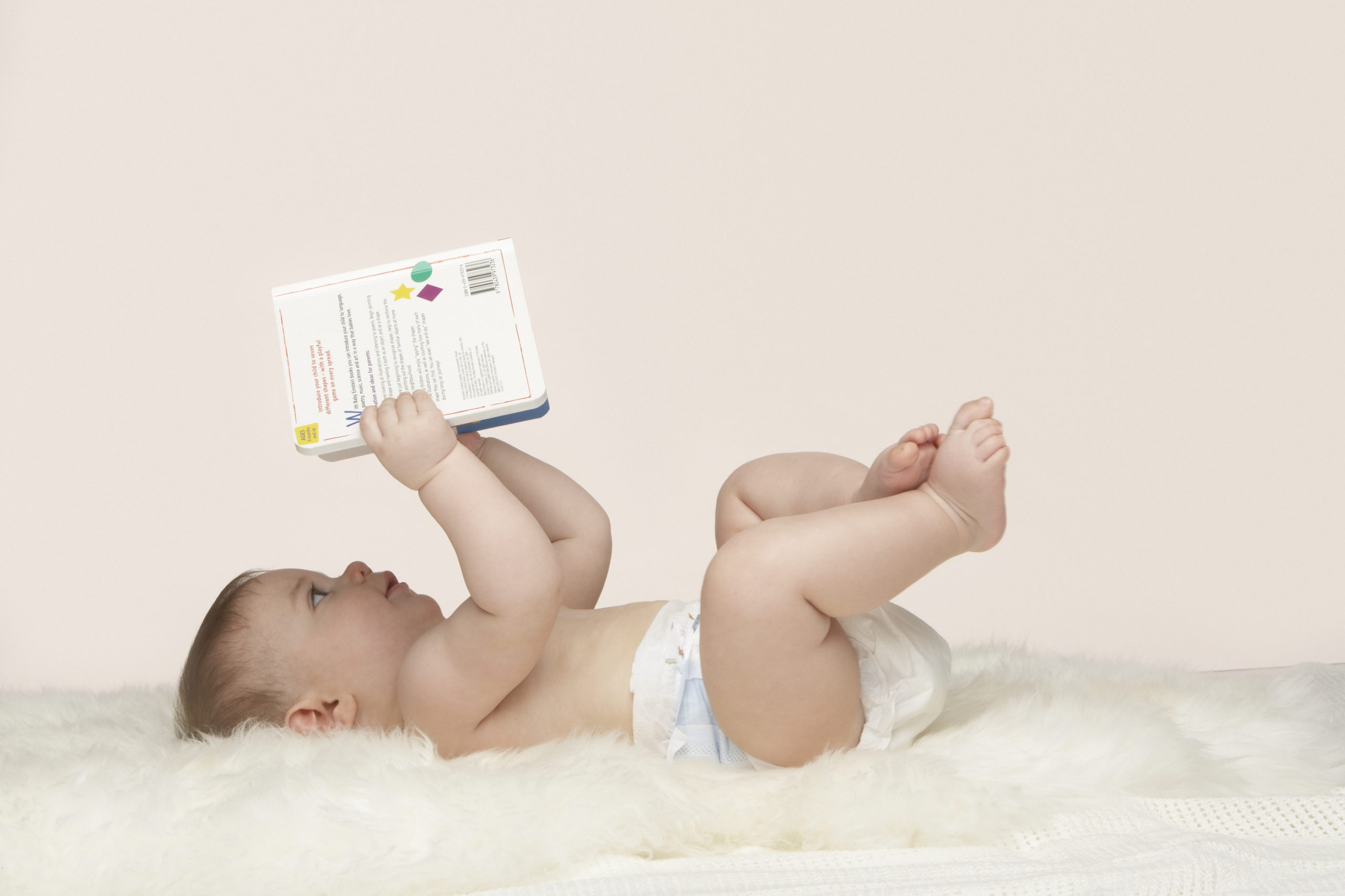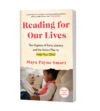By Laila Weir
Reading aloud from the start is key to setting your baby on the path to literacy. But with infants, you obviously don’t have to be reading stories per se. In fact, there don’t even have to be words on the page right at first. Early on, the idea is to capture babies’ attention and engage them with your voice, gestures, and facial expressions to spur a verbal or other response of their own. Coos, babbles, and book grabs encouraged!
As they get older, they’ll tune into the words and stories more and more, and notice the mechanics of how you crack open the book, turn the pages, and read from the front to the back. They’ll discover that books are for reading (not just chewing), that they’re read in a particular direction, and that they convey certain ideas that parents return to each time they open them. All these simple elements are actually crucial building blocks towards reading. A tip: Engaging with your baby around the book is key. See our post on how to engage kids during story time.
Ok, so hopefully you’re sold on sharing books with your little lump of sleepy cuteness. But what books should you “read” to them? Here’s the lowdown on baby books that will help you capture infants’ attention and set them out on the path towards reading.
Noise Books
Choo-choo! Moo! Baaaa. Tick-tock.
Books that focus on the noises and sounds that animals or objects make are perennially popular with babies, making them excellent candidates to capture your infant’s attention.
They also build the child’s awareness of the sounds that underpin speech. This is a crucial step in building early language—and it will eventually aid them in picking out individual sounds in words as they learn to read and write.
Noise books provide a particularly rich opportunity for adult-child interaction, as well. For example, as you read a favorite noise book to your child (probably for the umpteenth time), you may find yourself naturally prompting them to join in, even before they can really make the sounds: What does the doggy say? That’s right! Woof-woof.
This kind of interaction is gold. In fact, it’s more precious than that. Because, as it turns out, research has shown that babies acquire speech sounds by interacting with the people around them. Not by watching someone speak on TV. Not by listening to a recording of a person speaking. Only by interacting.
For all these reasons, books that feature farm animal sounds, transportation noises, and other exaggerated speech sounds of all sorts make a great addition to your baby’s bookshelf.
Bonus: If you want to dig deeper, books that emphasize the letter sounds of M, N, B, P, D, Y, W, and H are especially well adapted for building your baby’s sound awareness. Moo, baa, and bow-wow, here we come!
Nursery Rhyme Books
Rhyming (hickory dickory dock, the mouse ran up the clock) and alliteration (Peter, Peter, pumpkin-eater) are also great for developing baby’s sound awareness. Both are common features in classic and new nursery rhymes—which are also playful, lilting, frequently silly, and all-around fun.
These features make time-tested nursery rhymes, as well as modern takes on the old form, excellent choices for reading with babies. They’re also perfect vehicles for encouraging some key parent behaviors that help babies learn language: making eye contact and speaking in exaggerated and sing-song tones, as well as interacting with and responding to the baby.
Learn more in our article about the benefits of nursery rhymes.
Books with Character Names
Many baby books don’t have characters, per se, and this is fine, up to a point. But reading infants books about actual characters who have names can heighten their attention, researchers have found.
“For infants, finding books that name different characters may lead to higher-quality shared book reading experiences and result in … learning and brain development benefits,” writes psychologist Lisa S. Scott.
Scott also points out that books with named characters may lead parents to talk more with their babies when they read together. So, whether it’s Jack and Jill or Pete the Cat, look to include some stories with character names in your shared reading with baby.
Photo Books
Books with simple text and real photography are also a great bet to capture babies’ attention. Plus, studies have shown that very young kids are more likely to connect realistic images of objects with the objects themselves—thereby better learning the words associated with them—than with more abstract artistic representations or less lifelike cartoons. (Don’t worry, there will be lots of time for the pretty art later on!)
Showing babies color photos of everyday items and reading the accompanying labels expands their vocabularies in ways they find fascinating. At the same time, if you point out the word at the same time, it can help them begin to realize that the letters on the page are also associated with the item. Learning the connection between an object, a spoken word, and a written word is a key literacy skill.
Bold and High-Contrast Books
You may have heard that newborns can only see in black and white, an assumption that spawned a whole genre of black-and-white books for infants, but current analysis suggests that’s not true.
While they can’t see as well as adults at first, research indicates that infants see much like adults, according to Russell D. Hamer of Florida Atlantic University. Hamer writes that a newborn’s vision is a “rapidly developing version of adult vision, rich in pattern, contrast, and color, and that it possesses some remarkable abilities for discrimination and complex pattern recognition.”
Nevertheless, there is scientific reason to believe that bold, bright, and high-contrast patterns and shapes best draw the attention of infants during the first few months of life at least.
Face Books (including Mirror Books!)
Babies are also drawn to photos and images of other infants and children with parents or siblings, and to circles and face-like shapes in general. In fact, one study documented fetuses showing a preference for face-like shapes before they were even born!
The Global Babies series from the Global Fund for Children is a beautiful set of books featuring photos of babies from cultures around the world. There are a number of charming books in the series, including the original Global Babies, Global Baby Girls, Global Baby Boys, and more. As your baby gets older, you may want to move into books with realistic illustrations, but baby faces will remain popular with your little audience.
Books with faces also offer an opportunity to expose your infant to people from diverse backgrounds. Research into “face bias” has shown that newborns look at all faces equally, but that as they get older, babies who primarily see faces from their own race can’t recognize and remember individuals from other races as well. Choosing books featuring a diversity of faces may combat that effect. Plus, they’re fun!
Tip: Your infant’s own face will fascinate them, too, so look for baby books that include a mirror as well. These cute books also give lots of chances for interaction and giggles together.
More Tips for Reading with Baby
Keep in mind that even as you move into books with more detailed illustrations and more complicated storylines when your baby gets a little older, not all books have to have words on the page. Check out our post on how to use wordless picture books to support literacy.
When the books do have words, though, be sure to point them out. Make them a focal point (albeit a lesser one) along with the story and images. Take a look at our post on 5 Reading Aloud Tips to Get Your Child Kindergarten Ready for tips on how to do this.
Also, be sure to look for board books or fabric books. Most popular children’s books, even longer and more sophisticated stories, are available in board-book form these days, and it’s well worth it.
When your baby reaches for a book you’re reading to them, it’s a sign of engagement, and you want to encourage that! Letting them interact directly with books increases that engagement. So go ahead and let them play with their books, turn the pages, look at the pictures while riding in their stroller or car seat, and, yes, even mouth them!
Have fun looking at, playing with, chatting about … and even reading … books to your baby! Then let us know your favorite “reads” for infants in the comments.


